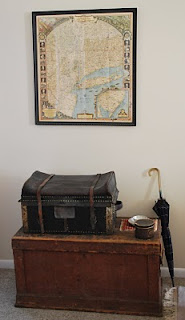
As a scholar of material culture, this is a concept in which I strongly believe and on which my research relies, but sometimes it takes moments like these to reinforce the importance of (and perhaps refresh my belief in) the cultural meanings embedded in objects. A few weeks ago, I had an opportunity to think about my own stuff critically for a material culture historiography class I am taking as part of my Ph.D. coursework at the University of Delaware. After reading and discussing Evocative Objects: Things We Think With, a collection of essays edited by Sherry Turkle about what certain objects mean to individuals, I had to write my own "object biography" using an object of my choice. After rejecting the things that would tell far too personal stories, I settled on my glasses.
I knew my glasses were important to me. As I explain in the second paragraph of my essay, "Anyone who has carelessly plucked my glasses from a table, thereby threatening to smudge the lenses or frames with their oily fingers, or accidentally sat within a foot of them, has met my wrath." But I never took the time to consider what they meant to me until now. Are they a mere tool?

They are necessary for my professional life, but I can survive without them. As I explain in the essay, however, "by the time I was wearing my second pair [of glasses], they became a part of my sense of self." Why did my more recent quest to find the "right" pair last four months and involve a fine Philadelphia boutique, an online purveyor of vintage frames, and the local eyeglass chain store? After taking thirty minutes too long to find a greeting card on one recent trip to the mall, my mom said that the card didn't need to match my personal aesthetic. But, really, it did (I take pride in my stationary), and so do my glasses. They were selected not to stand out but to blend in, to represent me and to embody the things I value or find to be important about myself (brains, not beauty; quirkiness, not grace; quality, not mass production; me, not the other girl wearing glasses).
If only all my historical subjects left behind essays explaining what their things meant to them...but that would put me out of a job and take all the fun out of the research and interpretation. Essays such as those in Turkle's Evocative Objects, periodic realizations such as the once I cite at the beginning of this entry, and opportunities to reflect on my own stuff remind me that even the most anonymous object meant something to someone and therefore can tell us something important about our cultural and social history.
Although those explanatory essays, letters, and journal entries about "evocative objects" of the past are few and far between, they do crop up every now and then. Last January, Tyler and I stumbled into an antique shop in northern Delaware where I picked up a pack of letters featuring correspondence written by a Pennsylvania railroad man to his “dearest wife” during the late nineteenth-century. The topics he wrote about range from the circumstances under which he worked for the railroad; his experiences patronizing a boarding house; the difficulties he experienced using the mail service; and the his family’s financial and health hardships.

In one letter dated 6 August 1873, C. G. Cadwallader gives readers a glimpse into his world of evocative objects: "When I look around my room and see the different things the old clock ticked up with the key, the dog with its broken head, the faces behind the clock, and the paper holder and pictures suspended on the wall, they all seem to speak to me in a language of their own that calls to mind many many scenes...and looking around my room and over these there is always a something wanting and my mind flashes off to my dear wife and child. Ah, it isn't home without them." For Cadwallader, the things that populated his immediate surroundings represented the people (and perhaps a less itinerant lifestyle) he missed.

Are Cadwallader's letters fodder for the next sociocultural interpretation of late nineteenth century railroad work in Pennsylvania? For now, just like my exercise in apartment staging, they reminded me that objects always have and always will matter to people.
Further Reading,
Sherry Turkle, ed., Evocative Objects: Things We Think With (Cambridge, Mass.: MIT Press, c2007).
No comments:
Post a Comment